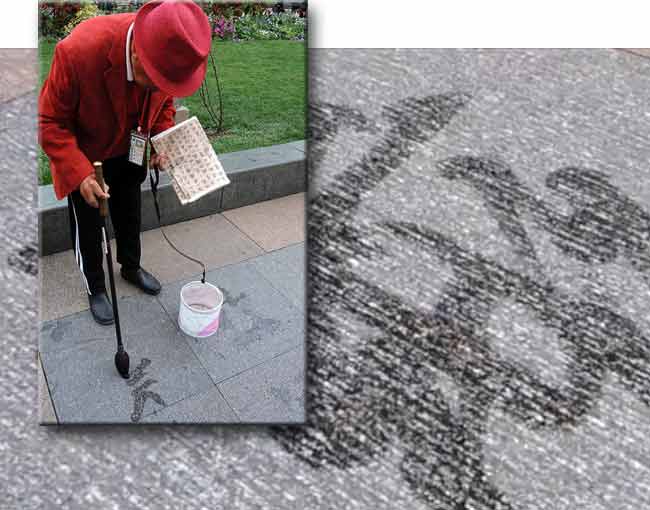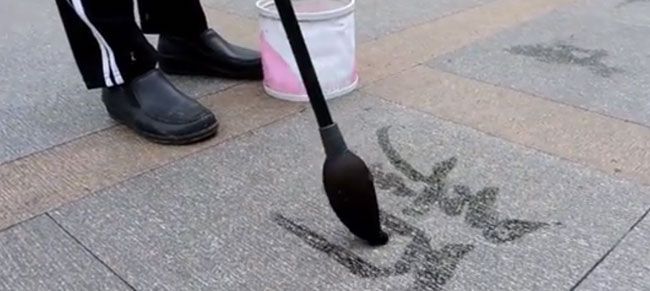He steps back one tile, dragging along the container with water. He dips the brush into the water and with a steady hand starts writing the next character. The wet parts of the pavement beautifully contrast with the lighter, dry surface. It must be difficult, handling this stick of almost a meter long with one arm, holding it at the very end. Rather than writing, it's a physical exercise. Actually, it's a mental exercise: an incredible concentration is at the basis of this action. It isn't a muscular effort alone.
Has he designed the brush himself? It is not a brush, really. It is a pointed bag, made of seamless fabric, with a sponge inside. The materials have to be well chosen to make just enough water flow out on the pavement to build the strokes. Or is this a form of calligraphy that more people pursue which means this kind of writing tool is readily available in specialized shops?
He pauses not, he speaks not, and he neither eats nor drinks in between. He doesn't even carry a flask with tea or hot water with him, like many Chinese do. He doesn't look up from the pavement except for when he peeps in his notebook from which he copies the characters. He is writing a classical text. But he writes the words one by one. As if there is no connection between the characters. The Chinese who stop to look at what he is doing also don't try to read lines. They simply look at the one character he is writing at that time. Are they so mesmerized by his intent action that they don't care what text it is? Or is in the end the text merely a frame and irrelevant in this exercise?
Nobody dares to talk to him. His body language clearly states that he shall not be disturbed in his action. Continuity is an integral part of this concentration drill that will last for hours. A drill sanctioned by the government: around his neck hangs his identity card. As if the police or whoever wants to check on him may read it without him pausing.
It is early spring now and there is just a bleak sun every now and then. The mark remains visible for a long time. So he uses a large part of the pavement. How will it be in summer? Will during the hot season the first character of a row dry up before he can start a new series? It is amazing how passers-by, without deliberate effort, manage to avoid walking on the marks, leaving most of the characters intact until they are evaporated.
I regret I don't have my seal with me, or the inkpad. Otherwise I would have pressed it onto the pavement as a sign of approval and admiration of the work, like the Chinese do with a work of calligraphy on paper.

By Walther Tjon Pian Gi/Creative consultant/owner Nyukwha
As a theatre performer and activist in the field of culture and media Walther is particularly interested in the way people incorporate arts, culture and religion in their daily lives. Living in different places and travelling (live or from his armchair) teaches him a lot. Walther shares his experiences and reflections through stories and pictures which he then publishes on his blogs www.cityofparamaribo.nl and www.travelpod.com/s/trips/nyukwha. Read more
Pictures: Nyukwha
More Travel & Leisure articles /
Do you wish to write for Colors?






